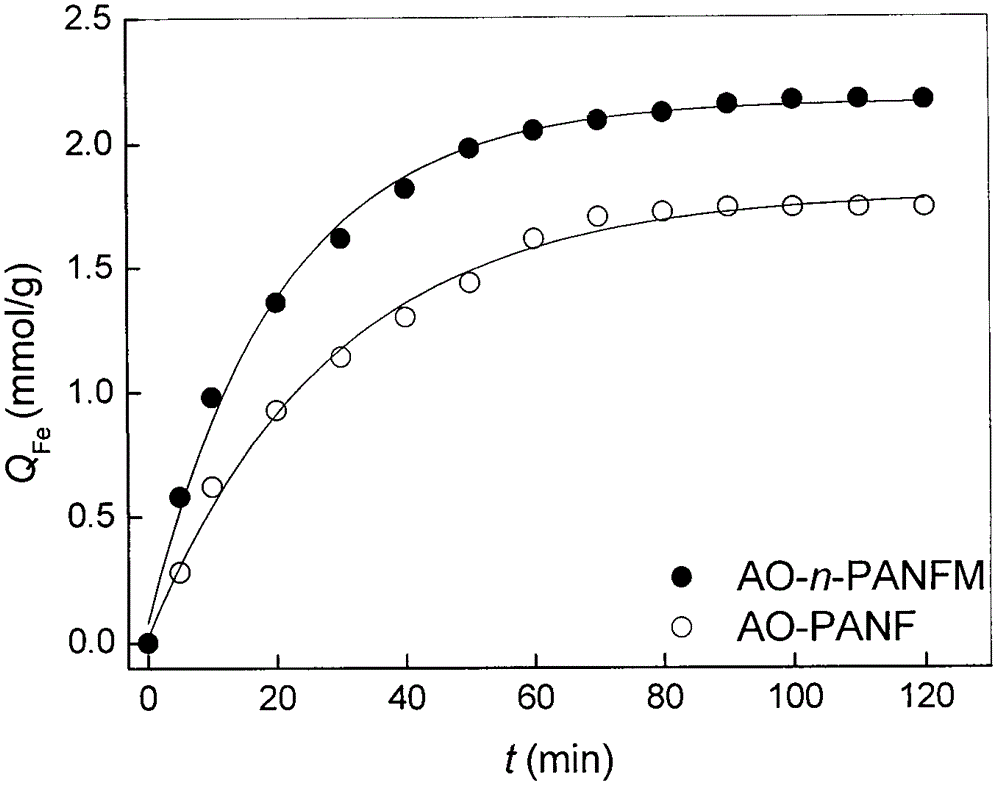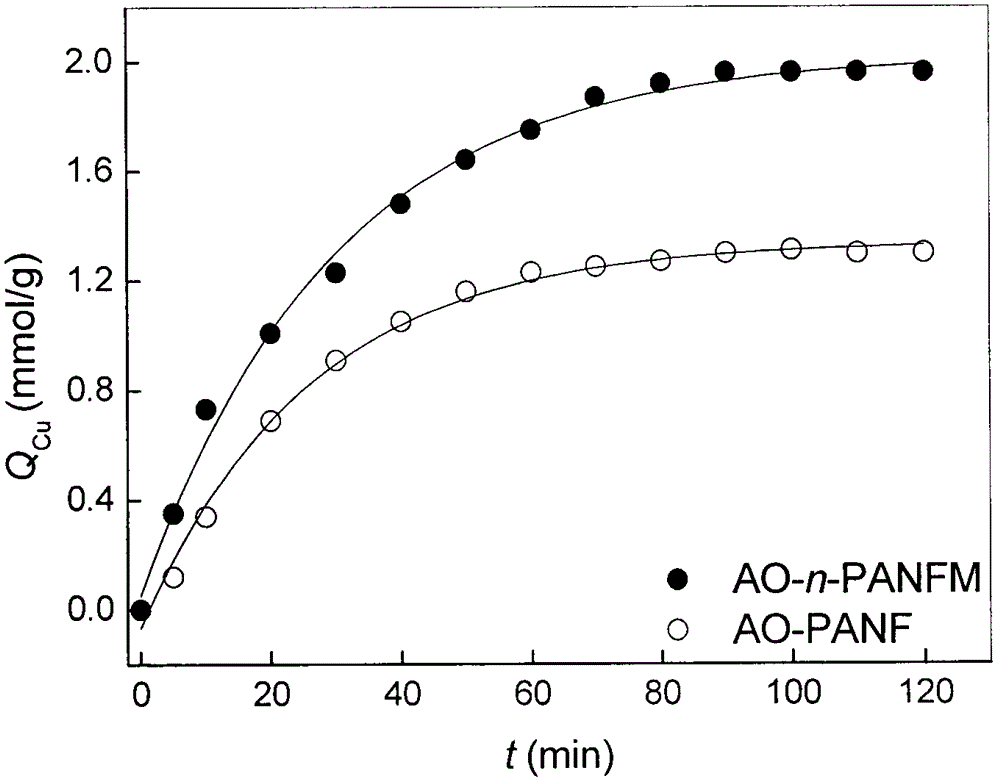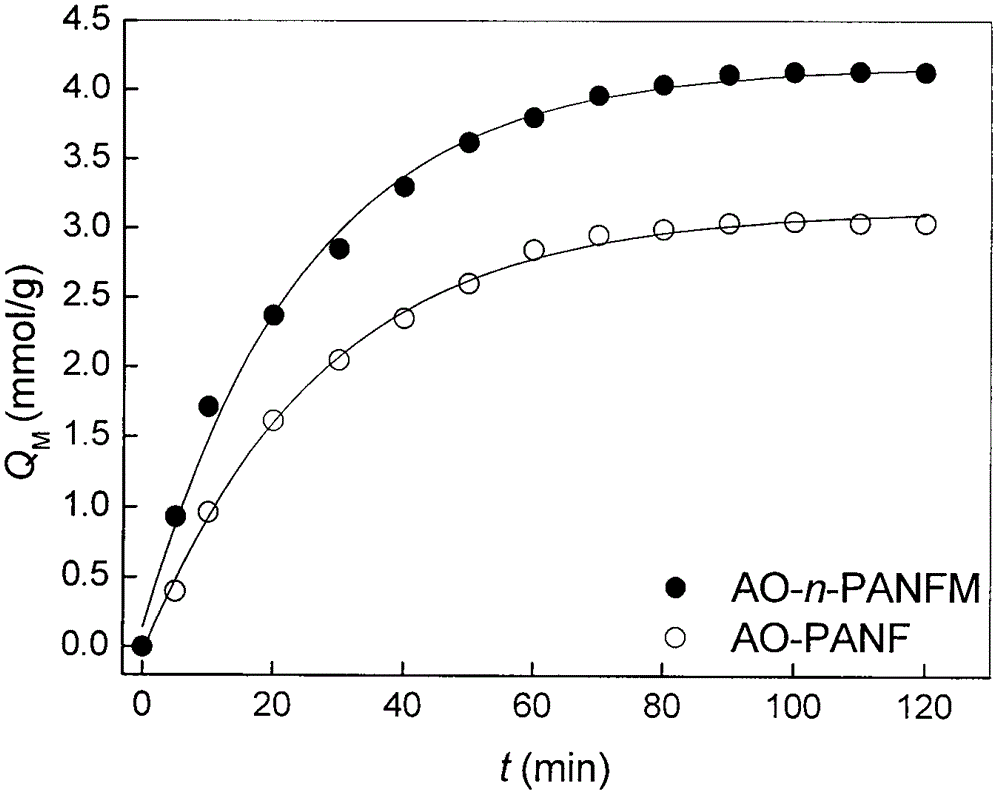Amidoxime-modified polyacrylonitrile nanofiber membrane bimetallic complex catalyst and preparation method thereof
A technology of nanofiber membrane and polyacrylonitrile, which is applied in organic compound/hydride/coordination complex catalysts, physical/chemical process catalysts, chemical instruments and methods, etc., to achieve good adaptability, easy industrial promotion, and good catalysis active effect
- Summary
- Abstract
- Description
- Claims
- Application Information
AI Technical Summary
Problems solved by technology
Method used
Image
Examples
Embodiment 1
[0036] 1. Pretreatment of ordinary polyacrylonitrile fibers: immerse polyacrylonitrile yarns in a 1:1 mixed solution of ethanol and water at 25°C for 30 minutes, take them out and dry them in vacuum at 50°C for 3 hours for later use;
[0037] 2. The spinning of polyacrylonitrile nanofiber film: the polyacrylonitrile yarn of the described pretreatment of 16.0g accurately weighed, and it is immersed in the N of 84.0g, N-dimethylformamide solvent dissolves completely A polyacrylonitrile spinning solution with a mass fraction of 16.0% was prepared. The spinning of polyacrylonitrile nanofiber membrane was carried out on a self-made electrospinning device. By controlling the extrusion rate (0.60ml / h) of the spinning solution and the voltage (25kV) at the needle, the spinning solution was ejected from the needle and Drafting forms a white polyacrylonitrile nanofiber film on the surface of the rotating disk, wherein the fiber diameter is measured by Image-Pro Plus6.0 software as 510.3...
Embodiment 2
[0044] 1, 2, 3, 4 and 6 steps of technology are respectively the same as 1, 2, 3, 4 and 6 steps of technology in Example 1.
[0045] 5. Preparation of mixed aqueous solution of metal ions: use ferric chloride and copper sulfate to prepare a mixed aqueous solution of metal ions with a molar concentration of 0.1M. The molar concentration ratio of iron ions to copper ions in the mixed aqueous solution is required to be 3:1, and then After the resulting mixed solution was left to stand for 4 hours, it was filtered for subsequent use;
[0046] The prepared second amidoxime-modified polyacrylonitrile nanofiber membrane bimetallic complex catalyst (referred to as Fe-Cu-AO-n-PANFM-2) is brown in color. After measurement and calculation, the contents of iron ions and copper ions in the catalyst are 3.15mmol / g and 1.01mmol / g respectively.
Embodiment 3
[0048] 1, 2, 3, 4 and 6 steps of technology are respectively the same as 1, 2, 3, 4 and 6 steps of technology in Example 1.
[0049] 5. Preparation of mixed aqueous solution of metal ions: use ferric chloride and copper sulfate to prepare a mixed aqueous solution of metal ions with a molar concentration of 0.1M. The molar concentration ratio of iron ions to copper ions in the mixed aqueous solution is required to be 1:3, and then After the resulting mixed solution was left to stand for 4 hours, it was filtered for subsequent use;
[0050] The prepared third amidoxime-modified polyacrylonitrile nanofiber membrane bimetallic complex catalyst (referred to as Fe-Cu-AO-n-PANFM-3) is brown. Through measurement and calculation, the contents of iron ions and copper ions in the catalyst are 1.03mmol / g and 3.07mmol / g respectively.
PUM
| Property | Measurement | Unit |
|---|---|---|
| diameter | aaaaa | aaaaa |
| diameter | aaaaa | aaaaa |
| specific surface area | aaaaa | aaaaa |
Abstract
Description
Claims
Application Information
 Login to View More
Login to View More - R&D Engineer
- R&D Manager
- IP Professional
- Industry Leading Data Capabilities
- Powerful AI technology
- Patent DNA Extraction
Browse by: Latest US Patents, China's latest patents, Technical Efficacy Thesaurus, Application Domain, Technology Topic, Popular Technical Reports.
© 2024 PatSnap. All rights reserved.Legal|Privacy policy|Modern Slavery Act Transparency Statement|Sitemap|About US| Contact US: help@patsnap.com










